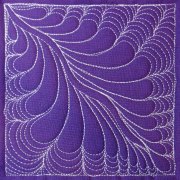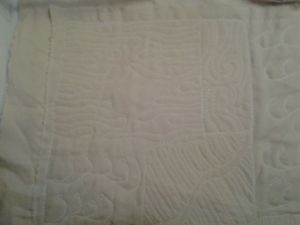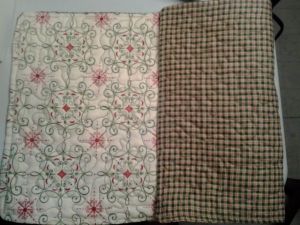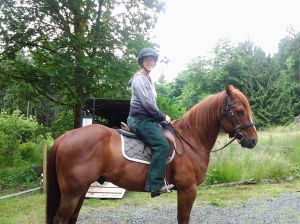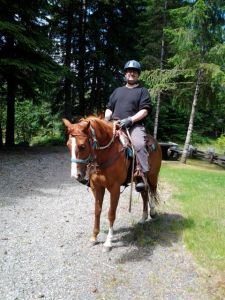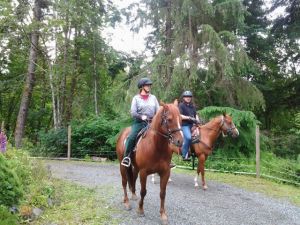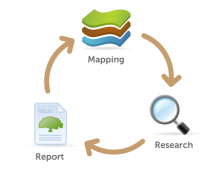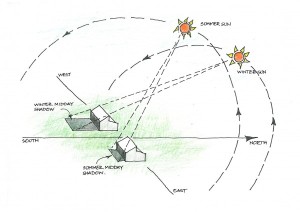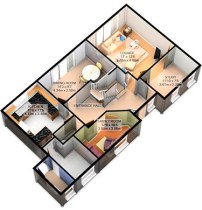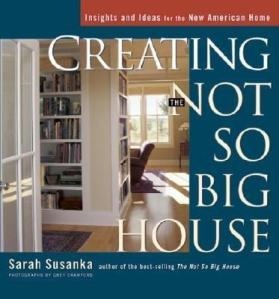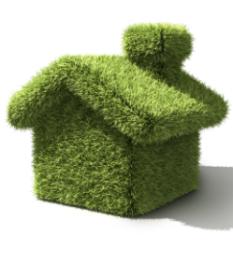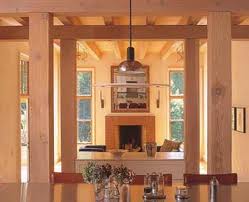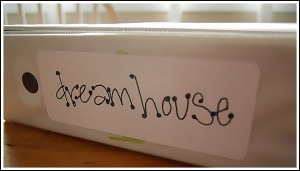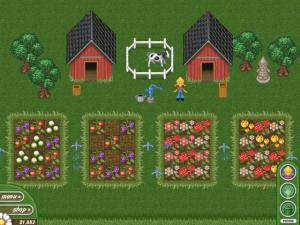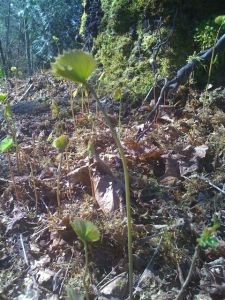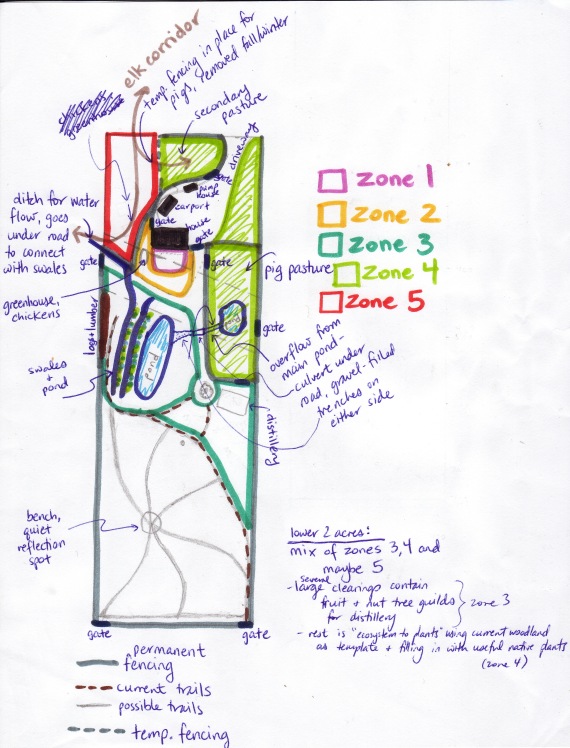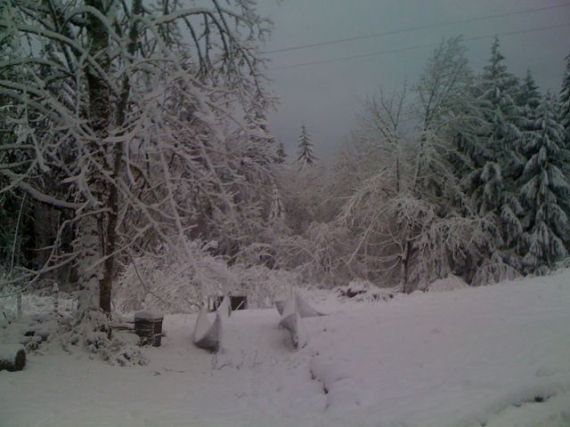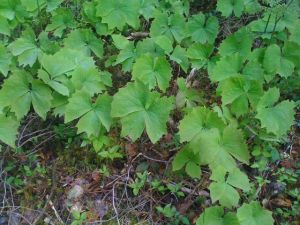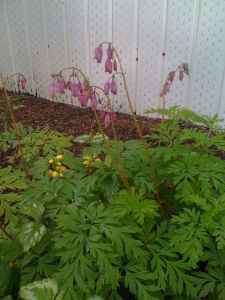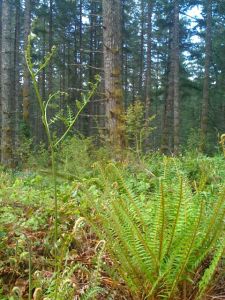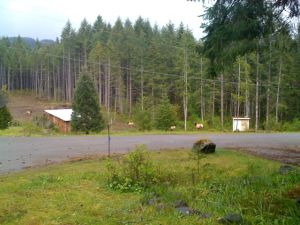A few years ago after I learned to knit and discovered that I was, in fact, somewhat creative I became interested in quilting. I loved the look of quilts and the creativity involved in putting them together. I grabbed a couple of books from the library and got rather excited looking at all the patterns. Then I read about how one actually quilts and decided that hour upon hour of hand-sewing was not something I was interested in doing.
More recently, when I began planning in earnest for our new home, I thought about how moving to a bigger house often means having to fill that extra space with Stuff, and I wrote a post about how I didn’t want to get sucked into buying things that had no meaning or would fall apart after a while. I imagined crafting the things that would fill my new home and that brought my thoughts back to quilting. The kids would have their own rooms and I thought how wonderful it would be to have a lovely hand-made quilt for each of them, not to mention one for the grownups’ bed. So I decided to look into it again.
At the library I found a book about something called machine quilting and I got very excited. You could do this on a sewing machine? Way cool. The book was brief but it got me Googling. I found the Missouri Star Quilt Company, which has great video tutorials on its site. And then I found my epiphany, my golden muse, the inspiration that moved me to action: The Free Motion Quilt Project. This blog was started by a young quilter named Leah Day, a petite soft-spoken gal from North Carolina with an adorable American accent. Frustrated by the lack of options out there for free motion quilting (FMQ) she set out to create one new pattern each day for a year. From there her website grew to include all sorts of wonderful articles and videos to guide one through machine quilting. I was hooked!
But I didn’t have a sewing machine.
Thanks to Leah’s website I had a good idea what to look for in a machine for FMQ. I’d been scouring Craigslist and UsedEverywhere but none of the machines offered had what I was looking for. Plus I knew I really needed to try these machines out before buying and that would be very difficult if I was trucking around all over town, dragging the kids with me, sitting in someone else’s home begging for fabric scraps!
I was getting impatient with just watching all Leah’s great videos: I was ready to get started! Luckily, over the last couple of months my consulting business suddenly got very busy and I was able to bring in a nice chunk of extra money for our family. I decided to treat myself and buy a new machine. I could certainly think of many uses for it besides quilting, like mending clothes, making cloth napkins and placemats and other things for the home. We don’t have a sewing machine store here in town so last week, when I had to head to the Big City for an appointment, I dropped by their main sewing store.
I “test drove” a few machines, using quilted samples the store had available. I didn’t tell the salesgirl that this was the first time I had ever FMQ’d before! I ended up falling in love with a model that was, of course, much more expensive than what I had planned to spend. But it was on sale and came with a quilter’s kit (FMQ foot, table extension, etc.) and had a nice large harp space for quilting. Not to mention a great work light (I had the sobering middle-aged lady experience of realizing that my eyes aren’t what they used to be). Mostly I just found sewing on this machine to be smooth and easy and it didn’t scare me! So I took the plunge and purchased my first sewing machine: a Pfaff Ambition 1.0.
I couldn’t wait to get started on it, and thankfully I had saved an old bed sheet that had a big hole in it, so I had plenty of fabric to play with. I also had a sewing kit I’d picked up from a friend’s yard sale years ago full of notions and scissors and thread. After reading the manual carefully and learning how to thread the machine and wind a bobbin, I was all set. I did a few runs of straight stitching before getting impatient and switching to the FMQ foot. I folded a swath of fabric four times over, sewed around the edges to form a rectangle, and then began to practice FMQ as per Leah’s instructions.
Not only was it as easy as she made it look (which confirms to me that I made a good choice in machines) but it was also just as fun as it looked, too! I am hooked. I had so much fun practising different designs. Here are a couple of my test swatches (I apologize for the photos being hard to see clearly: I only had this fabric and white thread, not a great combination for contrast):
Then I tried some other beginner designs from Leah’s website.
After several samples I was itching to make something “real”. Next chance I got I headed to the local FabricLand store and got myself a membership (my mother has had her membership since I was a wee child so it felt good to join) and came home with some “fat quarters” and a “charm pack”. I decided to use the fat quarters to make placemats that I would just FMQ without any piecing. The truth is, I don’t even own an iron let alone a rotary cutter, cutting board, or quilter’s ruler. It was rather slapdash, but turns out you don’t need much perfection to make a simple placemat. I was really pleased with how they came out (the colours of the plaid are much bolder in reality; not sure if you can see the stippling well either).
I’m planning on making some more placemats. Until I get an iron and some proper cutting tools that’s all I can do, but it will allow me to practice my FMQ while still producing something useful. There is an exception, however: I’m getting this quilting set from appleturnover‘s Etsy Store. The owner of the shop is a friend of mine from back in our mum-and-baby-group days. She asked me to be a tester for her quilting kit: the pieces are already cut and I will be quilting along with videos she shot on her lovely antique hand-crank machine. I’ll still need to get an iron, but the cutting tools can hold off for a while longer.
Stay tuned for more quilting projects!

